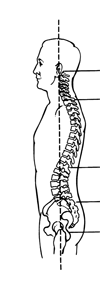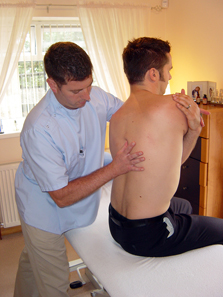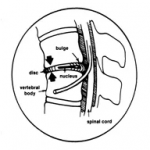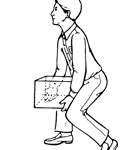Virtually everyone will experience some form of neck or back pain in their lifetime.
You are not alone. The pain may occur suddenly and go away within a few days or weeks, or it may go and come back in episodes over many years. It may also spread into the arm or leg. Back and neck pain will keep your attention and impact your activities of daily life.
You may have pain with:
- Sitting at the computer
- Rising from a chair
- Turning in bed
- Bending or twisting with yard work
- Standing or walking
- Swinging a golf club
- Lifting and playing with your kids
What causes it?
People are often puzzled by the cause of their back or neck pain. They will say “I just bent over to pick up a pencil and I got a sharp pain and now I can’t bend.” Or “all I did was sit at my computer for two hours.” There is no mystery here, and once the physiotherapist investigates further, the problems are more obvious. It is not that picking up a pencil is hard on your back, but it turned out that the person was bending in the garden for hours that day before it happened. In the other case the person had poor sitting posture and a poor set up at their computer. You don’t have to fall off a ladder or lift 50 kg to hurt your back. At least 70% of back and neck injuries begin with normal daily repeated activities.
The two main causes of back and neck pain are:
- Poor posture
- Poor body mechanics with for example: lifting, bending, pushing and pulling
Other important causes include poor flexibility, strength and fitness.
Poor posture:

In order to understand pain that arises in your neck or back from poor posture, try the following experiment: bend your finger backwards until you feel a stretch. There is no pain now, but hold it there for a minute or two, and pain or discomfort will occur. Pain is a warning signal by your body, and if you allow it to continue, damage will occur. Pain often develops as a result of strain and stretch on muscles and ligaments over time.
If you are seated in a poor, slouched posture, then your low-back has lost its natural curve or lordosis, your neck has an increased curve forwards, and your mid-back has an increased curve backwards (diagram below). A slouched posture puts the muscles, ligaments, and discs of your spine on an abnormal stretch, just as you tried in the experiment above. Pain can develop in a short time (minutes), or it can take months. The pain can also spread to your head in the form of headaches. Often the pain is relieved when you change position, but as time goes on, if nothing is corrected, then the pain will persist in any position. If the posture is not corrected, (in sitting or standing) eventually the muscles and ligaments will shorten and become tighter, and you lose flexibility in their neck and back. A loss of flexibility is also a cause of back and neck problems.
Poor body mechanics with bending and lifting:
The second most common cause of neck and back pain is repeated bending, lifting, and stooping. The discs of your lower back can become damaged from poor posture and poor lifting technique. The outer wall of the disc can develop small tears in it, which allows the gel-like center to bulge backwards. If the bulge is large enough, it will push on the nerve behind it called a “pinched nerve”.
The key to prevention is keeping the normal curves in your neck and back while lifting, stooping, and bending. It is especially important to position your low back arched inwards (lordosis) when lifting. This is the strong position for your back. In the strong position, the muscles and ligaments are in a perfect position to perform at their maximum.
We can help!

A physiotherapy program has to address the above causes for a person to improve. If the mechanical cause of the pain is removed (poor posture or poor body mechanics) then the pain improves. Successful treatment comes with teaching a person about their back and how to lessen strain and stress on their neck and back. Treatment also focuses on special exercises to reduce strain, stretch tight muscles, strengthen and create faster healing.
Massage therapy may be used to help ease the neck or back, allowing it to move and stretch easier. To help pain and healing they may also use many proven treatments like ultrasound, heat, acupuncture, and gentle electrical therapy. They will also teach special movements to reduce pain, and heal a bulging disc.
Patients are taught ways of easing the pain at home or at work such as using a proper support for sitting and how to use the lower back at work or during sports without injuring it further. Teaching self-treatment and promoting independence is a very important part of physiotherapy treatment.
As a person improves, special exercises are used to strengthen muscles and stretch tight muscles and joints. The physiotherapist is an expert in choosing the right exercises and technique for each person.
What are the benefits?
- Kill and decrease pain
- Heal faster
- Improve with less or no medication
- Learn how to treat neck and back pain on your own
- Understand neck and back pain and learn there are no mysteries
- Learn long term solutions
- Get back to your passions and pursue life!
Don’t let pain stand in your way! Physiotherapy will help.

